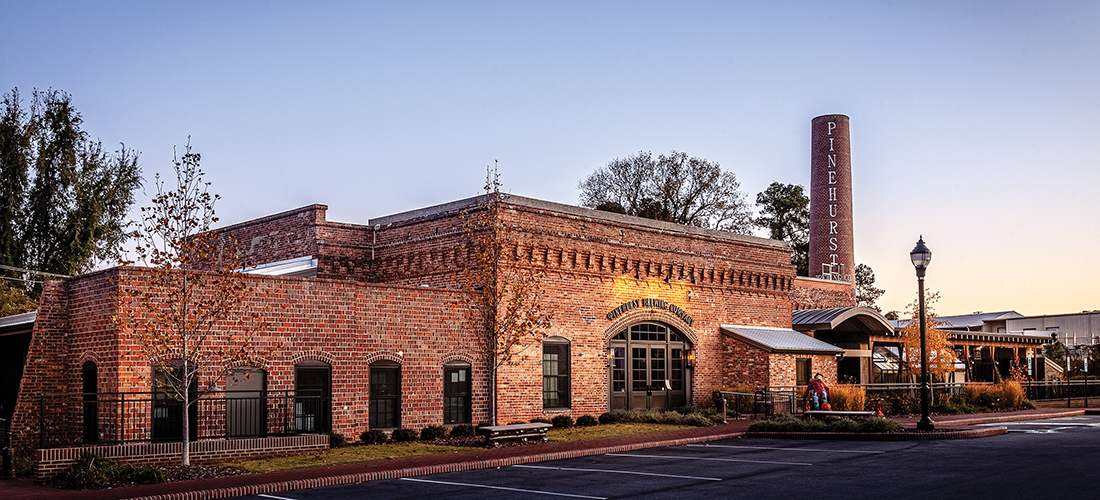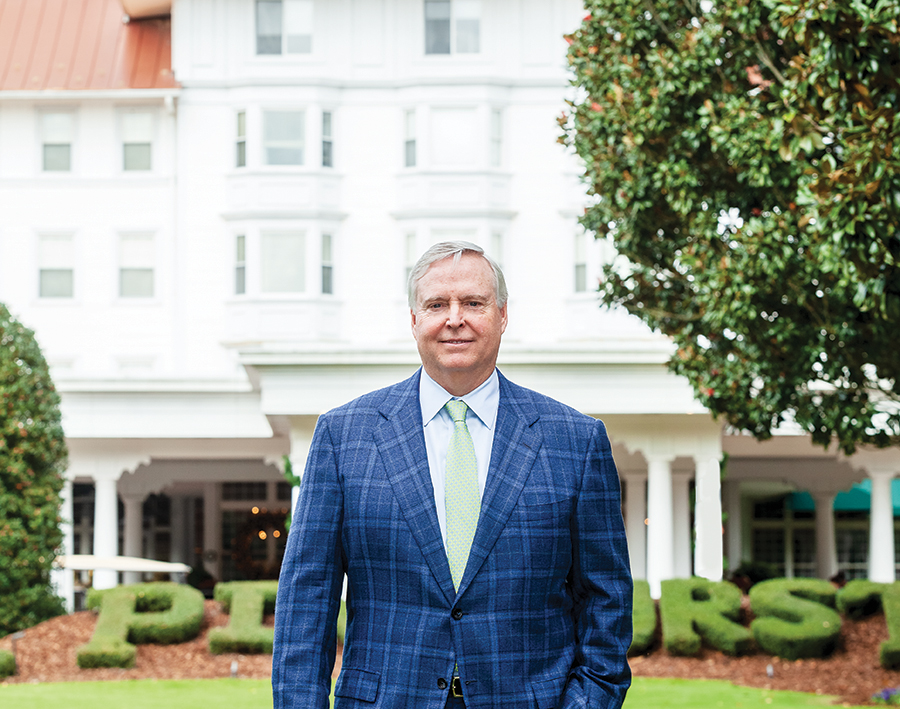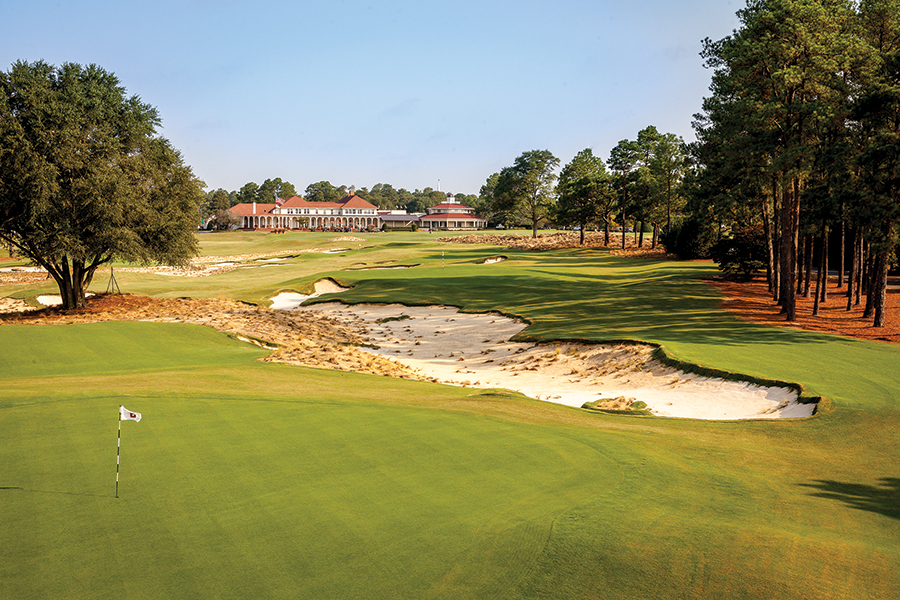
A steady hand guides the Pinehurst Resort
By Bill Fields • Photographs by John Koob Gessner
On a sunny, warm day in late September, the golf courses at Pinehurst Resort and Country Club were full and the streets in the village bustled. Coming up on 125 years since James Walker Tufts founded Pinehurst as a retreat for the sick, his creation — long since having evolved into a haven for recreation instead of recuperation — seldom had seemed as robust.
“There’s always opportunities to do better, but things are good right now,” Bob Dedman Jr. says, responding that afternoon to a visitor’s observation about the vitality. “God willing and the creek don’t rise — no more hurricanes, like 2018 — this should be our best year in the history of the property. Hopefully, that bodes well for the future as well.”
Far beyond the bottom line, the past and the future often meld into discussions of the present for Dedman, who as owner of the historic property has been unafraid to take bold steps on the tightrope between yesterday and tomorrow.
“It’s like the history of the resort has now come full circle,” says Audrey Moriarty, executive director of the Tufts Archives and Given Memorial Library. “It was started by one man who had a vision. And now we’re back essentially to one man who has a vision and who can see something that isn’t there. There is a strong parallel.”
Over the last decade, under the leadership of Dedman and his management team — including President Tom Pashley — a destination that dawned in the 19th century has confidently polished its status in the 21st.
Pinehurst’s No. 2 Course was dramatically restored to its Donald Ross-era glory by Bill Coore and Ben Crenshaw; Gil Hanse renovated the No. 4 Course, crafting a stellar design on some of the best golf land in the Sandhills; near the clubhouse Hanse also created The Cradle, a nine-hole par 3 layout that can be played with a couple of clubs, and Thistle Dhu, a putting course, both with an emphasis on fun.
An abandoned steam plant was transformed into the popular Pinehurst Brewing Co.; The Deuce became a perfect après-golf grill overlooking the 18th green of No. 2; the members’ clubhouse and Carolina Hotel dining room were renovated; new swimming, fitness and beach facilities were constructed for members; and, more recently, the Manor Inn was refurbished, a wholesale spiffing-up that echoes what was done to a dilapidated Holly Inn years ago.
“We’ve always gone back and tried to be more authentic and restore the character of Pinehurst,” says Dedman, general partner of Putterboy, Ltd. “But at the same time, contemporize and make it so the legacy will last — allow it to be more relevant for the next hundred years. Part of it is looking back, but part of it is about always looking forward.”
Pinehurst has been part of the Dedman family business since 1984, when ClubCorp, founded by Robert H. Dedman Sr., purchased the property from a consortium of banks, adding to its large stable of golf courses and city clubs. The Tufts family had sold in 1970 to Diamondhead Corporation, whose focus was on selling lots and condominiums, many of the latter built only a mild slice off the fairways of the No. 3 and No. 5 courses. The jewel, No. 2, had returned to hosting tour golf, but much of its architectural essence was lost. By the time Diamondhead (then called Purcell) turned Pinehurst over to the banks in 1982, there was a lot of debt and no less consternation about what had changed in the decade-plus of corporate ownership.
Dedman Sr., whose vast wealth couldn’t have been more different from his dirt-poor roots in rural Arkansas, had built his empire buying distressed clubs and turning them around. At Pinehurst, he saw huge opportunity in the formidable challenge.

“The first time I stood in front of the clubhouse and looked out on all those ribbons of fairway, I got tears in my eyes,” he told Sports Illustrated in 1999. “I had always venerated Pinehurst for its place in the history of golf, and when I finally saw it I knew instantly that we would take this fallen angel and make it not as good as it was, but better than it had ever been.”
The elder Dedman was a striver for the ages, leaving a house without electricity or indoor plumbing to reside with an aunt in Dallas in order to seek an education and a different way of life. Bob Sr. got multiple degrees, became an attorney and later a wildly successful businessman. He was a billionaire who gave away millions, far exceeding his childhood plan to be worth $50 million by age 50 and give away $1 million annually to good causes. (Southern Methodist University, where the law school is named for the Dedman family and Bob Jr. is chairman of the university’s board of trustees, has received more than $80 million in donations from the family.)
Bob Sr. commanded a room, a talker who could quote the classic poets and more earthy philosophers with equal ease. “He has more sayings than anybody I’ve ever met,” Lamar Hunt, who founded the American Football League and owned the Kansas City Chiefs, told The New York Times in 1986. “He’s the only person who, while playing tennis, will get your ears tired before your legs.”
Despite his success, Dedman never lost his feel for the everyman. As Bob Jr. noted in a tribute following his father’s death, at age 76, in 2002, “He inherently knew the wisdom of the Italian proverb, ‘At the end of the game, they put the king and the pawn back in the same box,’” Bob Jr. wrote in the SMU Law Review.
Bob Jr. was born in 1957, the same year his father got into the golf club business by starting Brookhaven Country Club in Dallas. Although it was a single facility, his optimism showed in the name for his new company: Country Clubs, Inc.
“I am incredibly fortunate,” Bob Jr. says. “There are two things they say parents give kids — one is roots and the other is wings. And that’s really about the values. Neither my father nor my mother, Nancy, were perfect, but they gave us opportunities, an education and values that were a foundation for the future. They encouraged us to be involved with our communities and have a positive impact on a lot of people.”
The younger Dedman acknowledges that his dad “was bigger than life,” an extrovert whose achievements were all the more striking given the hardscrabble circumstances of his early years. Bob Jr. — who returned to ClubCorp in 1987 as chief financial officer after three years in investment banking, was named president and chief operating officer in 1989, chief executive officer in 1998 and chairman of the board in 2002 — isn’t as voluble.
“He’s kind of a quiet man but confident,” Moriarty says. “He says what he means and gets what he wants, but not in a pushy way. I personally find him to be very kind.”
Hanse discovered the same thing when he and his design partner, Jim Wagner, took on the tasks of creating The Cradle and Thistle Dhu, then rebuilding the No. 4 course. “Bob has been extremely gracious to my wife, Tracey, and me and our whole team,” says Hanse. “He uses the phrase, ‘We’re happy to have you be part of the Pinehurst family now,’ and as someone who loves the history of the game and appreciates the role Pinehurst has had in the history of golf in the United States, that means so much to me.”
In 2006, ClubCorp sold its large portfolio of golf properties but kept the one that had come to mean so much to the Dedman family. From that point, Bob Jr. has led one project after another at Pinehurst to try to ensure its popularity and relevance — to make a revered place even better.
“It’s that balance we try to strike, between the old and the new,” Dedman says. “We’ve got to get that balance right. We’re always mindful of that.”
If his father’s era at Pinehurst had been about fixing what neglect and misguided management had caused following the sale by the Tufts family, under Dedman Jr., the resort has innovated beyond a solid status quo.
“I think the village can learn from them,” says Kevin Drum, a council member since 2017 who established the Drum & Quill Public House in 2014. “They’re thinking long-term, re-investing. You make your future, you just don’t let it happen — you don’t wait for your future to occur. His dad was an empire builder, but what Jr. has done to build on the Pinehurst legacy, which is pretty spectacular, might be harder.”
With the 2014 U.S. Open on the near horizon following successful Opens in 1999 and 2005, and the Great Recession having hammered Pinehurst’s revenue stream, Dedman nonetheless decided to set in motion a dramatic change to the No. 2 course.
“Restoring No. 2 frankly took a lot of fortitude,” Dedman says of Coore and Crenshaw’s 2010 wholesale transformation. “I’m sure Bill and Ben were nervous, as we were. You try not to make too many bet-the-farm decisions. It would have been an embarrassment, clearly, if it hadn’t worked out well. But we needed to get back to the design intent of Ross.”
Hanse says, “Gutsy is the perfect word. To 95 percent of people in the golf world, it was not broken. But the reality was it had strayed so far from Ross’ vision and gone in a completely different direction. None of this (Pinehurst’s subsequent golf development) happens without Bob’s decision to restore No. 2. That got the ball rolling.”
As with the work of Coore and Crenshaw, Dedman gave Hanse the freedom to create once a goal was established. “Every architect would love to have an owner like that,” Hanse says, “to allow us to focus on the details of accomplishing the big-picture goals. Some people get more in the weeds and the details and others are less involved. I think Bob struck a very happy medium about that. He was knowledgeable about what was going on — and interested and invested in it — but he wasn’t, for lack of a better phrase, meddlesome. We fully expect a client is going to poke and prod and ask constructive questions, and we better have the answers. Bob was able to do that in such a gracious, gentlemanly way.”

Although he isn’t a carbon copy of his father, Dedman’s management style does take cues from him. “One of the lessons I learned from my father is the more our people do and the less I do the better off we all do,” he says. “You’ve got to give people the vision, of what you’re trying to accomplish, but then let them figure out how to execute it best.”
Dedman’s decision to turn the former steam plant into a brewery arguably was as bold as going ahead with the facelift of No. 2 course. “They thought I’d lost my mind,” he recalls of when he first broached the idea with his staff. “It had been decommissioned years prior and was kind of our white-elephant burial ground — just for storage, literally falling down and overgrown with vegetation. I just thought it was an incredible opportunity to take an unused asset and turn it around and make it something viable for the community.”
The Pinehurst Brewing Co. celebrated its first anniversary in the fall, golfers and non-golfers alike drawn in droves to the beer and food served in the stunning revival of a building that had been left to die.
“I’ve always said Pinehurst (resort) is the anchor in my mall, and I couldn’t be here if they weren’t here,” says Tom Stewart, who opened Old Sport & Gallery, a golf art and memorabilia shop in the village in 1997. “I don’t think the resort has been this busy since before 9/11. And that translates to my business too. It’s always been a company town. It’s diversified a bit, but it’s still a golf town.”
Although Dedman, a father of two daughters, still lives in Dallas with his wife, Rachael, he comes to Pinehurst monthly, staying in Fownes Cottage. “I’d like to think we have a good relationship with the village and that it’s getting better,” he says. “We each have our proper roles, but we like to partner with the village. We’re here for the long haul, and so are they. Hopefully, it’s a synergistic and symbiotic relationship. It needs to be a win-win for both of us.”
Dedman might not be in the village as often as his father was, but is active and visible in the Sandhills on his visits.
“He’s smart as can be, and he listens to people,” Stewart says. “He’s going to make it a better community by being involved.”
Pinehurst is a much larger community than it was when ClubCorp purchased the resort in 1984, the village population roughly tripling, to more than 15,000 in that span. “I think we need to have responsible growth,” Dedman says. “You don’t ever want to see this place get too big. It does need to grow and change and be consistent with the expectations of the times and its citizens and meet their needs. But hopefully not denigrate the special character of this place.”
As for golf — what has underpinned Pinehurst as much as longleaf pines and fresh air — Hanse believes the smart innovation led by Dedman is key.
“I think they have to continue pushing that very fine line between respect for the tradition of Pinehurst and the interjection of sort of modern thoughts and approaches to what makes golf fun and interesting,” Hanse says. “I think so far, they’ve struck the perfect balance. I hope they continue to do that and expect that they will.”
What might Pinehurst look like 35 years from now?
“Hopefully, it is golf heaven on earth,” Dedman says. “I hope we’re able to embellish the character of it even more so than we have. There is something special about this place — part golf, of course, but it goes beyond that. It’s the village and quality of people in this community. It’s our employees and our members. Our family’s been fortunate to be involved with ownership. But it’s definitely not a possession. It’s more than that.” PS





